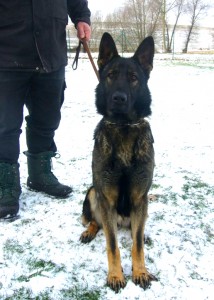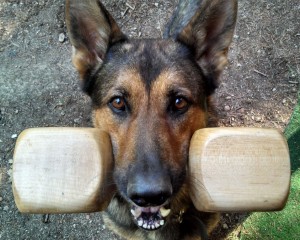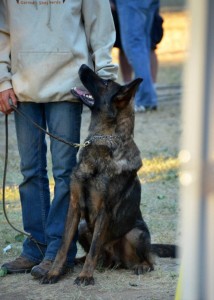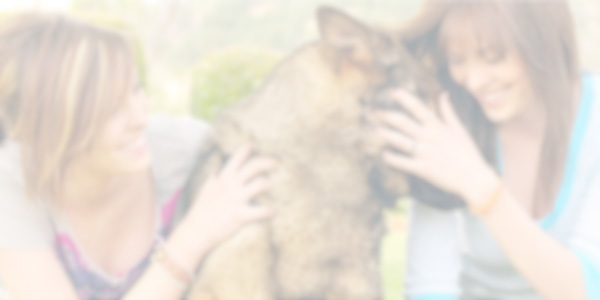Winter Workouts with Your German Shepherd Watch Dog
 With much of the country buried under snow or swimming in rain, there is no question that winter is upon us. While the winter weather is welcomed by many (particularly those in drought-stricken areas of the country), it can prove difficult to provide enough physical exercise and mental stimulation for our canine companions and working dogs. Fortunately, winter provides the perfect time to brush up on foundational skills, to teach new tricks, or to work on body awareness and core conditioning for dogs. Even though you may be trapped inside by inclement weather, there is no reason for you and your dog to be bored! In this blog, we will discuss skill training ideas for the working German Shepherd Dog and family companion alike.
With much of the country buried under snow or swimming in rain, there is no question that winter is upon us. While the winter weather is welcomed by many (particularly those in drought-stricken areas of the country), it can prove difficult to provide enough physical exercise and mental stimulation for our canine companions and working dogs. Fortunately, winter provides the perfect time to brush up on foundational skills, to teach new tricks, or to work on body awareness and core conditioning for dogs. Even though you may be trapped inside by inclement weather, there is no reason for you and your dog to be bored! In this blog, we will discuss skill training ideas for the working German Shepherd Dog and family companion alike.
Skill Training Ideas for German Shepherd Dogs & Family Companions
Now is the time to hone those finer skills for performance. Many IPO competitors use the “off season” time in the winter to work on improving their dog’s basic skills, in order to create a more polished performance overall. Examples of activities include:
 Dumbbell holds: the objective is to create a firmer, quieter hold on the dumbbell while in the proper ‘front’ position. Many handlers often switch to a piece of PVC pipe or a plastic or wooden dowel to help improve the dog’s hold, teaching them to sit calmly, quietly, and closely in front of the handler while holding this object. Later they transition back to the wooden dumbbell. This is the time to make the “hold in front” a very rewarding place to be! Keep sessions short and highly motivating, to keep the dog from becoming bored or tired of this exercise. While family companion dogs may never have a need to hold a wooden dumbbell, teaching the “hold” can be the first step in teaching the companion dog to retrieve objects back to the handler. The “hold” exercise helps the dog learn to hang on to whatever object it is handed by its handler. This exercise can be expanded to toys, tote bags, purses, even your car keys. Some dogs have even been trained to help carry in groceries!
Dumbbell holds: the objective is to create a firmer, quieter hold on the dumbbell while in the proper ‘front’ position. Many handlers often switch to a piece of PVC pipe or a plastic or wooden dowel to help improve the dog’s hold, teaching them to sit calmly, quietly, and closely in front of the handler while holding this object. Later they transition back to the wooden dumbbell. This is the time to make the “hold in front” a very rewarding place to be! Keep sessions short and highly motivating, to keep the dog from becoming bored or tired of this exercise. While family companion dogs may never have a need to hold a wooden dumbbell, teaching the “hold” can be the first step in teaching the companion dog to retrieve objects back to the handler. The “hold” exercise helps the dog learn to hang on to whatever object it is handed by its handler. This exercise can be expanded to toys, tote bags, purses, even your car keys. Some dogs have even been trained to help carry in groceries!
 Focus: the objective is to improve focus and duration of intense eye contact. Whether it is in the basic position, in the front position, in a sit or down or stand position, focus remains a crucial part of a polished performance. Focus can be marked, rewarded, and increased in duration gradually, and put on cue (such as “Watch” or “Look”). Add distractions a little at a time, and shorten the time required for focus first when building it in the presence of a distraction. Using another tug or ball on the ground can be a great distraction for the toy-motivated dog, and a pile of food can work for the food-driven dog. Focus is also essential for the companion dog, as it is the precursor to teaching any basic obedience exercise. Having a “Watch” or “Look” command can come in handy when in public, such as when walking on a busy sidewalk, or when passing an unruly dog or a passerby who is clearly afraid of your dog.
Focus: the objective is to improve focus and duration of intense eye contact. Whether it is in the basic position, in the front position, in a sit or down or stand position, focus remains a crucial part of a polished performance. Focus can be marked, rewarded, and increased in duration gradually, and put on cue (such as “Watch” or “Look”). Add distractions a little at a time, and shorten the time required for focus first when building it in the presence of a distraction. Using another tug or ball on the ground can be a great distraction for the toy-motivated dog, and a pile of food can work for the food-driven dog. Focus is also essential for the companion dog, as it is the precursor to teaching any basic obedience exercise. Having a “Watch” or “Look” command can come in handy when in public, such as when walking on a busy sidewalk, or when passing an unruly dog or a passerby who is clearly afraid of your dog.
- Mark/Watch: the objective is to teach a “Mark” versus a “Watch” command to the dog. This is an extension of teaching focus and eye contact, where the dog now learns to distinguish between a “Watch” command (or “Look”), where he looks at the handler, and a “Mark” command, where he looks straight ahead at an object or person and focuses on that instead. This is useful in teaching a dog to appropriately “Mark” jumps, blinds, the send-out, dumbbells for retrieves, and the helper in protection work (the cue is faded by the time competition comes). The “Mark” command can be taught using a ball or tug at first, or even the dog’s dinner as a focal point for the dog. The dog might need a little help at first with refocusing away from the handler, especially if the handler has done a lot of focus work to this point. Once the “Mark” cue is learned, the handler can switch between “Watch” and “Mark”, alternately rewarding either behavior. For companion dogs, this command is useful for helping the dog focus on a specific ball or toy that has been thrown for a retrieve, for example. It is also an essential part of any games involving targeting.
- Fronts: the objective is to create close and straight fronts, and to teach the dog to straighten himself out when he comes into the front position from any angle. This is the end stage of the formal recall (and the retrieve), and ideally the dog sits directly in front of the handler, so close that he is almost touching his handler’s legs. A hallway or chairs or stools can be used to funnel the dog directly in front of the handler, allowing the handler to reinforce the perfect position first without worrying about the dog being sloppy. Later, these props are faded, and the dog is taught to come in straight from any direction. Teaching pivots on/around an object can also help with teaching the dog to “fix” his front position, by teaching him to always move his hind end so that he lines up with you in the front position. For companion dogs, this exercise is a great extension of “Focus”, and can also be part of a formal recall. When this is taught correctly, most dogs come racing to the front position when given the command, even from great distances.
- Position changes: the objective is to improve reaction time, responsiveness to cues, and positioning with the Sit, Down, and Stand positions. Working on changes in position allow the handler to clarify cues, reward speed of response, and proof the three different exercises. Position changes can be done while stationery, or even with the dog on a small platform to prevent any forward movement. Motion can be added later, such as backing down a hallway with the dog in front, and then giving a Sit, Down, or Stand command, or heeling with the dog a short way and then giving a position command. For the pet owner, proofing the dog’s Sit, Down, and Stand are invaluable; the end result is a dog that is happily obedient to all three commands, that sits when asked, that lays down and stays there until released (excellent for keeping the dog from begging), and that will stand for grooming or examination.
This is just a sampling of skill exercises that can be improved during the winter months. However, skill training can extend to certain tracking and protection work skills as well. Is the dog having difficulty with proper article indications on the track? Practice article indications in the house, to solidify the actual indication behavior. Having trouble with control in the back transport during protection? Work on “Transport” for a ball in the house, which can be done with a ball on the ground or chair, or hanging on a send-out pole in the yard (once it dries out a little!). This is an excellent place to make use of your “Mark” cue as well, transitioning to “Transport” as you add movement into the equation.
Next article, we will discuss different conditioning and balance exercises you can do with your dog while inside the house. Until then, have fun training your dog!

